Team Tower Challenge
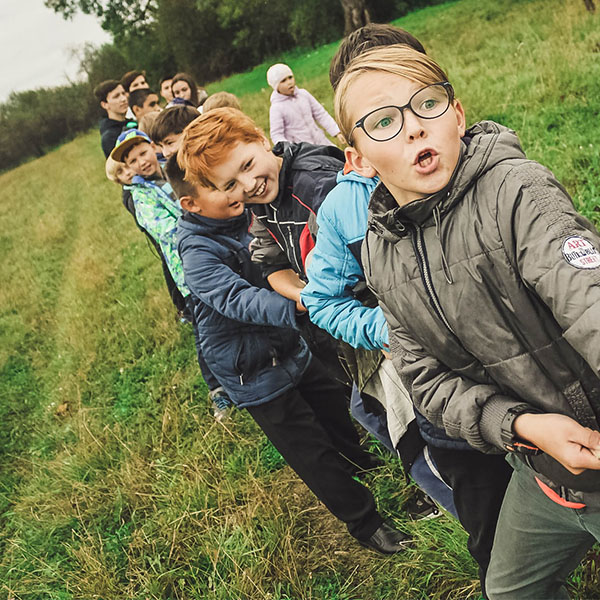
Group of students working together (Anna Samoylova, Unsplash)

Group of students working together (Anna Samoylova, Unsplash)
How does this align with my curriculum?
| Grade | Course | Topic |
|---|
Students will explore what it means to be a member of a team and highlight the skills and qualities that make one a good team member.
Overview
| Activities | Timing | Student Grouping | Description |
|---|---|---|---|
| Minds-On: What makes a good team member? | 15-20 minutes | Large group | Students discuss and identify the characteristics of good team members. |
| Action: Cup Stacking Challenge | 15-20 minutes | Small group | Students work as a team to solve a problem and practice listening, communication and teamwork skills. |
| Consolidation: Group and Individual Reflection | 15-20 minutes | Small groups and Individual | Students reflect on the activity they completed and their actions in the teamwork challenge activity. |
Students will:
- Understand what characteristics make a good team members and describe themselves as a team member
- Recognize that teamwork skills are required in the workplace
- Recognize that internal and external forces act on structures
Learning Goals
Students will:
- Understand what characteristics make a good team members and describe themselves as a team member
- Recognize that teamwork skills are required in the workplace
- Recognize that internal and external forces act on structures
Students can:
- Describe the characteristics of a good team member (e.g., helpful to others, good listener, shares the work, etc.)
- Demonstrate good teamwork skills when working in groups when building towers
- Identify specific careers or workplaces in which teamwork skills are used (e.g., construction workers, firefighters, etc.)
- Identify the internal and external forces acting on a given structure (e.g., internal force of cups on each other, external force of gravity)
Success Criteria
Students can:
- Describe the characteristics of a good team member (e.g., helpful to others, good listener, shares the work, etc.)
- Demonstrate good teamwork skills when working in groups when building towers
- Identify specific careers or workplaces in which teamwork skills are used (e.g., construction workers, firefighters, etc.)
- Identify the internal and external forces acting on a given structure (e.g., internal force of cups on each other, external force of gravity)
This icon indicates potential assessment opportunities.
Observations
- Observe and record anecdotally students’ responses to the questions about the characteristics of a good team member (Minds-on)
- Observe and record student actions that demonstrate they are a good team member (Action)
- Observe students as they take actions or make adjustments to address the forces that act on their structures (Action)
Conversations
- Listen to and record students as they share ideas about what it means to be a good team member (Minds-on)
- Have conversations with students about what makes a person a good team member (Minds-on, Action)
- Talk with students about the forces acting on their structures as they are building them (Action)
Products
- Review the Being Part of the Team Exit Slip and compare with personal observations (Consolidation)
- Review student sketches on Forces on Cup Towers reproducible (Consolidation)
Evidence of Student Learning
This icon indicates potential assessment opportunities.
Observations
- Observe and record anecdotally students’ responses to the questions about the characteristics of a good team member (Minds-on)
- Observe and record student actions that demonstrate they are a good team member (Action)
- Observe students as they take actions or make adjustments to address the forces that act on their structures (Action)
Conversations
- Listen to and record students as they share ideas about what it means to be a good team member (Minds-on)
- Have conversations with students about what makes a person a good team member (Minds-on, Action)
- Talk with students about the forces acting on their structures as they are building them (Action)
Products
- Review the Being Part of the Team Exit Slip and compare with personal observations (Consolidation)
- Review student sketches on Forces on Cup Towers reproducible (Consolidation)
Students will:
- Understand what characteristics make a good team members and describe themselves as a team member
- Recognize that teamwork skills are required in the workplace
- Recognize that internal and external forces act on structures
Learning Goals
Students will:
- Understand what characteristics make a good team members and describe themselves as a team member
- Recognize that teamwork skills are required in the workplace
- Recognize that internal and external forces act on structures
Students can:
- Describe the characteristics of a good team member (e.g., helpful to others, good listener, shares the work, etc.)
- Demonstrate good teamwork skills when working in groups when building towers
- Identify specific careers or workplaces in which teamwork skills are used (e.g., construction workers, firefighters, etc.)
- Identify the internal and external forces acting on a given structure (e.g., internal force of cups on each other, external force of gravity)
Success Criteria
Students can:
- Describe the characteristics of a good team member (e.g., helpful to others, good listener, shares the work, etc.)
- Demonstrate good teamwork skills when working in groups when building towers
- Identify specific careers or workplaces in which teamwork skills are used (e.g., construction workers, firefighters, etc.)
- Identify the internal and external forces acting on a given structure (e.g., internal force of cups on each other, external force of gravity)
This icon indicates potential assessment opportunities.
Observations
- Observe and record anecdotally students’ responses to the questions about the characteristics of a good team member (Minds-on)
- Observe and record student actions that demonstrate they are a good team member (Action)
- Observe students as they take actions or make adjustments to address the forces that act on their structures (Action)
Conversations
- Listen to and record students as they share ideas about what it means to be a good team member (Minds-on)
- Have conversations with students about what makes a person a good team member (Minds-on, Action)
- Talk with students about the forces acting on their structures as they are building them (Action)
Products
- Review the Being Part of the Team Exit Slip and compare with personal observations (Consolidation)
- Review student sketches on Forces on Cup Towers reproducible (Consolidation)
Evidence of Student Learning
This icon indicates potential assessment opportunities.
Observations
- Observe and record anecdotally students’ responses to the questions about the characteristics of a good team member (Minds-on)
- Observe and record student actions that demonstrate they are a good team member (Action)
- Observe students as they take actions or make adjustments to address the forces that act on their structures (Action)
Conversations
- Listen to and record students as they share ideas about what it means to be a good team member (Minds-on)
- Have conversations with students about what makes a person a good team member (Minds-on, Action)
- Talk with students about the forces acting on their structures as they are building them (Action)
Products
- Review the Being Part of the Team Exit Slip and compare with personal observations (Consolidation)
- Review student sketches on Forces on Cup Towers reproducible (Consolidation)
Materials and Preparation
| Material/Technology/Setting | Quantity |
|---|---|
* Could be substituted for other objects that could be stacked to form pyramids such as empty juice boxes, building blocks, etc. |
Per group |
* Could be substituted for a piece of string |
Per student |
|
For teacher use |
Materials
| Material/Technology/Setting | Quantity |
|---|---|
* Could be substituted for other objects that could be stacked to form pyramids such as empty juice boxes, building blocks, etc. |
Per group |
* Could be substituted for a piece of string |
Per student |
|
For teacher use |
- You may wish to watch this cup game video prior to teaching this lesson.
- Arrange students into groups of 4.
- Organise the classroom to facilitate groups working on the cup stacking challenge. Each group will need to have a flat surface around which to work and upon which they will stack their cups.
Preparation
- You may wish to watch this cup game video prior to teaching this lesson.
- Arrange students into groups of 4.
- Organise the classroom to facilitate groups working on the cup stacking challenge. Each group will need to have a flat surface around which to work and upon which they will stack their cups.
- Some familiarity with concepts of internal and external forces.
Student Prior Knowledge and Skills
- Some familiarity with concepts of internal and external forces.
| Material/Technology/Setting | Quantity |
|---|---|
* Could be substituted for other objects that could be stacked to form pyramids such as empty juice boxes, building blocks, etc. |
Per group |
* Could be substituted for a piece of string |
Per student |
|
For teacher use |
Materials
| Material/Technology/Setting | Quantity |
|---|---|
* Could be substituted for other objects that could be stacked to form pyramids such as empty juice boxes, building blocks, etc. |
Per group |
* Could be substituted for a piece of string |
Per student |
|
For teacher use |
- You may wish to watch this cup game video prior to teaching this lesson.
- Arrange students into groups of 4.
- Organise the classroom to facilitate groups working on the cup stacking challenge. Each group will need to have a flat surface around which to work and upon which they will stack their cups.
Preparation
- You may wish to watch this cup game video prior to teaching this lesson.
- Arrange students into groups of 4.
- Organise the classroom to facilitate groups working on the cup stacking challenge. Each group will need to have a flat surface around which to work and upon which they will stack their cups.
- Some familiarity with concepts of internal and external forces.
Student Prior Knowledge and Skills
- Some familiarity with concepts of internal and external forces.
Teaching and Learning Activities
This icon indicates potential assessment opportunities.
Minds-On: What makes a good team member? [15 - 20 min.]
| Instructions | Teaching Tips |
|---|---|
|
Write the question “What makes a person a good team member?” on the board or on a large chart paper. Use a learning strategy, such as a Think-Pair-Share to structure and support student discussion. After pairs have discussed, have partners share their thoughts with the class. As students share their ideas, record the brainstormed list of words, qualities and descriptors of good team members. |
LanguagePut the recorded ideas in an accessible location. DiscussionsDiscussion prompts can include:
|
|
Provide students with a copy of Being Part of the Team reproducible [Google doc] [Word doc] [PDF] and have them complete Part 1. 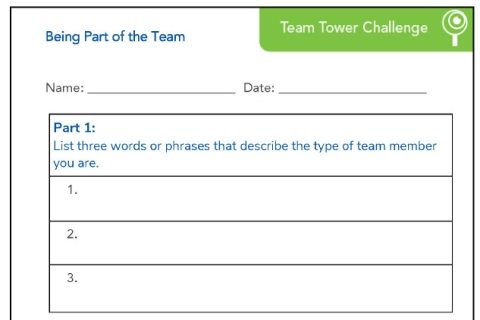
|
LanguageStudents can refer to the recorded ideas or add words of their own to their reproducibles. Alternatively, have students record the three words that best describe them as team members as an audio or video recording. |
Action: The Team Tower Challenge [30 - 40 min.]
| Instructions | Teaching Tips |
|---|---|
|
Explain that in this activity the class is going to be using teamwork skills to overcome a challenge. There are four parts to the challenge and each team member will take turns leading the team. Each team will have the following supplies:
|
SafetyUse non-latex elastic bands. |
|
There are four levels of difficulty in this challenge. Level 1 Challenge Students start with the cups right side up. They create a tower by stacking the cups within each other upside down. Each team member can use only one finger to help move the cups into position. 
Image - Text VersionShown is a black and white diagram of cups in a row, and in a stack. Level 2 Challenge Students start with the cups upside down. They create a pyramid in which the cups are upside down. Team members cannot touch cups with their hands. They also can use only the supplies provided. 
Image - Text VersionShown is a black and white diagram of cups in a row, and in a pyramid-shaped stack. Level 3 Challenge Students start with the cups right side up. They create a pyramid in which the cups are right side up. Team members cannot touch cups with their hands. They also can use only the supplies provided. 
Image - Text VersionShown is a black and white diagram of cups in a row, and in a stack. Level 4 Challenge Students start with the cups upside down. Their goal is to build the tallest cup tower possible. 
Image - Text VersionShown is a black and white diagram of cups in a row, and a question mark. The challenges are also outlined on the Team Tower Challenge Activity Card reproducible [Google doc] [Word doc] [PDF]. 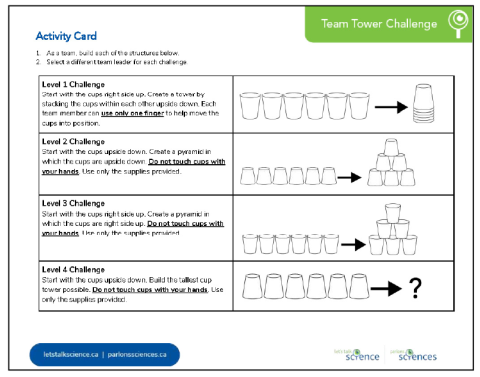
When questions are answered and expectations reviewed, have one member of each group come get their supplies. |
IdeaShow students what the finished product will look like for each of the levels. IdeaIf time is a factor, create the cup-stacking-tool for students in advance. IdeaThis video provides ideas for ways to differentiate this activity. Students with motor skill challenges could give instructions to a partner. They could also do all of the challenges using hands or other adaptive devices. IdeaRemind students that this is not a race and it doesn’t matter what they complete. The goal is to exhibit good teamwork skills. IdeaBefore students begin, review what can be used/not used in this challenge. Review the behavioural expectations (i.e., noise levels, use of elastic bands, etc.). |
|
During the challenge, have students explore the forces that are acting on each of the pyramids/towers they are building. Provide students with a copy of Forces on Cup Towers reproducible [Google doc] [Word doc] [PDF], 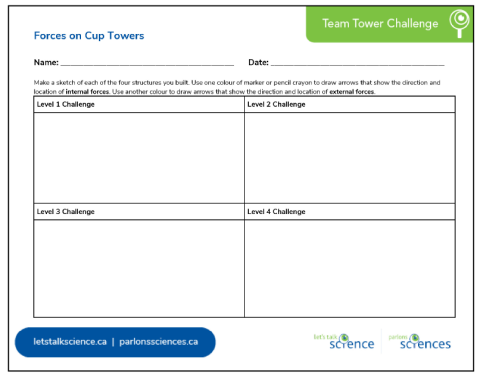
Have students make sketches of each of the four structures they built. They will then use one colour of marker or pencil crayon to draw arrows indicating the direction and location of internal forces and another colour to draw arrows for external forces. Below is a student sample; 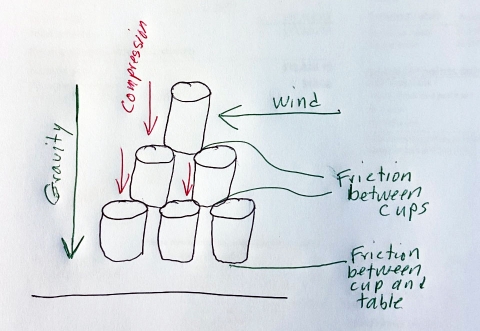
Image - Text VersionShown is a colour photograph of a drawing of six cups and the forces acting on them. |
DiscussionsDiscussion prompts could include:
IdeaStudents who need help with writing could be provided with cut outs of arrows with labels. They could move them around and then glue them on the drawing. If done online, these could be provided for students digitally. |
Consolidation: Group and Individual Reflection [20 - 30 min.]
| Instructions | Teaching Tips |
|---|---|
| Debrief the activity as a class. |
DiscussionsDiscussion prompts can include:
|
|
Refine and clarify the original brainstorm list of the characteristics of a good team member. Have students refer back to their Being Part of the Team Exit Slip reproducible [Google doc] [Word doc] [PDF] and, individually, answer Part 2, in which they describe how they could be better team members based on what happened during the activity. 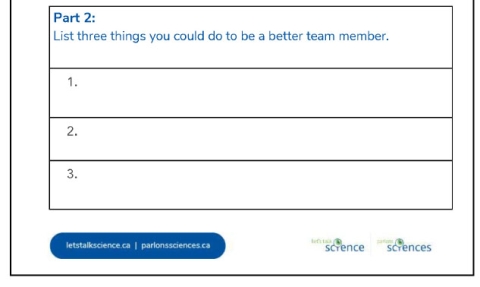
|
DiscussionsDiscussion prompts could include:
|
|
Have students brainstorm examples of careers or workplaces in which a team approach is used. Students could list the types of teamwork skills individuals in these careers or workplaces would need. |
Idea
ConnectionsThere are many real life careers and workplaces where people work in teams. Sometimes teams are longstanding and at other times they change depending on the problem and the skills needed. Some examples include: a team of engineers, technicians and skilled trades workers building a bridge; doctors, nurses, and other medical professionals in an operating room; the different skilled trades required to build a house; computer programmers creating a new piece of software. |
Background Information for Teachers
The importance of teamwork in the STEM workplace
Providing students with opportunities to explore their strengths and abilities, helps shape their future aspirations. Helping them develop their teamwork skills is one way we can have a positive effect on our students’ futures.

The old adage of “two heads are better than one” is an apt summary of the importance of teamwork. In a team, each individual brings a unique set of skills, experience and knowledge.
However, being a team member does not mean just being a good follower. Being an effective team member often indicates leadership potential as many of the skills required of team members are also required of leaders (i.e., the ability to communicate, engage in critical thinking, collaborate, empathise with others, show respect, and to be accountable. Good teamwork skills make a team much more than just a collection of individuals.

Teamwork skills are also highly valued in the workplace.
Workers who have STEM backgrounds are valued because teamwork skills are developed and nurtured through hands-on activities. This is true of both STEM and non-STEM workplaces/careers.

Let’s Talk Science appreciates the contributions of Tanya Clift, Gillian Petrini, Natalie McIlmoyle, Bonnie Alexander, and Sandra Harfoush in the development of this lesson plan.
Additional Resources
Reproducibles
- Team Tower Challenge Activity Card reproducible [Google doc] [Word doc] [PDF]
- Being Part of the Team Exit Slip reproducible [Google doc] [Word doc] [PDF]
- Forces on Cup Towers reproducible [Google doc] [Word doc] [PDF]
Reproducibles and Media
Reproducibles
- Team Tower Challenge Activity Card reproducible [Google doc] [Word doc] [PDF]
- Being Part of the Team Exit Slip reproducible [Google doc] [Word doc] [PDF]
- Forces on Cup Towers reproducible [Google doc] [Word doc] [PDF]
Science
- Students could discuss how various internal and external forces affect the stability of the structures they created in this challenge.
- Students could identify and discuss examples of careers or workplaces, that use science or technology concepts, in which a team/collaborative approach is used,
- Students could explore and develop strategies to improve the stability of their structures.
- Students could select a workplace where workers work in teams and research the different roles, skills, and knowledge each person brings to the team.
- Students could explore how teamwork was employed to build structures in the past such as pyramids, longhouses and tipis.
Literacy
- Students could write about how they felt as they worked on the challenge. Potential prompts include:
- What was their contribution to the team?
- Which of the teamwork skills, listed at the beginning of this lesson, do they feel they could improve? What can they do to improve these skills?
- What worked well for them in this activity? What was challenging?
Mathematical Thinking
- Students could create a mathematical model of the cup stacking challenge.
- Students could draw the top, front and side views of their cup pyramid.
Computational Thinking
- Students could design an algorithm that teams could use to solve the cup stacking challenge.
- Students could do an unplugged coding version of this activity on the Canada Learning Code website.
Extensions
Science
- Students could discuss how various internal and external forces affect the stability of the structures they created in this challenge.
- Students could identify and discuss examples of careers or workplaces, that use science or technology concepts, in which a team/collaborative approach is used,
- Students could explore and develop strategies to improve the stability of their structures.
- Students could select a workplace where workers work in teams and research the different roles, skills, and knowledge each person brings to the team.
- Students could explore how teamwork was employed to build structures in the past such as pyramids, longhouses and tipis.
Literacy
- Students could write about how they felt as they worked on the challenge. Potential prompts include:
- What was their contribution to the team?
- Which of the teamwork skills, listed at the beginning of this lesson, do they feel they could improve? What can they do to improve these skills?
- What worked well for them in this activity? What was challenging?
Mathematical Thinking
- Students could create a mathematical model of the cup stacking challenge.
- Students could draw the top, front and side views of their cup pyramid.
Computational Thinking
- Students could design an algorithm that teams could use to solve the cup stacking challenge.
- Students could do an unplugged coding version of this activity on the Canada Learning Code website.
Baker STEM Lab (2018). K-5 STEM Team Building Activity. Accessed July 13, 2022 at https://www.youtube.com/watch?v=lsPKRWGxXAE.
First Nations Pedagogy Online (n.d.). Talking Circles. Accessed July 13, 2022 at https://firstnationspedagogy.ca/circletalks.html
Kathleen Walde (n.d.). Developing Teamwork Skills Is an Investment in Your Career. Accessed July 13, 2022 at https://www.monster.com/career-advice/article/teamwork-skills
Kevin Eikenberry (2020). 10 Roles Every Leader Must Fill. Accessed July 13, 2022 at https://www.budtoboss.com/personal-professional-development/10-hats-leaders-must-wear/
Saylor Academy (2012). Chapter 19: Group Communication, Teamwork, and Leadership. Accessed July 13, 2022 at https://saylordotorg.github.io/text_business-communication-for-success/s23-05-teamwork-and-leadership.html
References
Baker STEM Lab (2018). K-5 STEM Team Building Activity. Accessed July 13, 2022 at https://www.youtube.com/watch?v=lsPKRWGxXAE.
First Nations Pedagogy Online (n.d.). Talking Circles. Accessed July 13, 2022 at https://firstnationspedagogy.ca/circletalks.html
Kathleen Walde (n.d.). Developing Teamwork Skills Is an Investment in Your Career. Accessed July 13, 2022 at https://www.monster.com/career-advice/article/teamwork-skills
Kevin Eikenberry (2020). 10 Roles Every Leader Must Fill. Accessed July 13, 2022 at https://www.budtoboss.com/personal-professional-development/10-hats-leaders-must-wear/
Saylor Academy (2012). Chapter 19: Group Communication, Teamwork, and Leadership. Accessed July 13, 2022 at https://saylordotorg.github.io/text_business-communication-for-success/s23-05-teamwork-and-leadership.html
Reproducibles
- Team Tower Challenge Activity Card reproducible [Google doc] [Word doc] [PDF]
- Being Part of the Team Exit Slip reproducible [Google doc] [Word doc] [PDF]
- Forces on Cup Towers reproducible [Google doc] [Word doc] [PDF]
Reproducibles and Media
Reproducibles
- Team Tower Challenge Activity Card reproducible [Google doc] [Word doc] [PDF]
- Being Part of the Team Exit Slip reproducible [Google doc] [Word doc] [PDF]
- Forces on Cup Towers reproducible [Google doc] [Word doc] [PDF]
Science
- Students could discuss how various internal and external forces affect the stability of the structures they created in this challenge.
- Students could identify and discuss examples of careers or workplaces, that use science or technology concepts, in which a team/collaborative approach is used,
- Students could explore and develop strategies to improve the stability of their structures.
- Students could select a workplace where workers work in teams and research the different roles, skills, and knowledge each person brings to the team.
- Students could explore how teamwork was employed to build structures in the past such as pyramids, longhouses and tipis.
Literacy
- Students could write about how they felt as they worked on the challenge. Potential prompts include:
- What was their contribution to the team?
- Which of the teamwork skills, listed at the beginning of this lesson, do they feel they could improve? What can they do to improve these skills?
- What worked well for them in this activity? What was challenging?
Mathematical Thinking
- Students could create a mathematical model of the cup stacking challenge.
- Students could draw the top, front and side views of their cup pyramid.
Computational Thinking
- Students could design an algorithm that teams could use to solve the cup stacking challenge.
- Students could do an unplugged coding version of this activity on the Canada Learning Code website.
Extensions
Science
- Students could discuss how various internal and external forces affect the stability of the structures they created in this challenge.
- Students could identify and discuss examples of careers or workplaces, that use science or technology concepts, in which a team/collaborative approach is used,
- Students could explore and develop strategies to improve the stability of their structures.
- Students could select a workplace where workers work in teams and research the different roles, skills, and knowledge each person brings to the team.
- Students could explore how teamwork was employed to build structures in the past such as pyramids, longhouses and tipis.
Literacy
- Students could write about how they felt as they worked on the challenge. Potential prompts include:
- What was their contribution to the team?
- Which of the teamwork skills, listed at the beginning of this lesson, do they feel they could improve? What can they do to improve these skills?
- What worked well for them in this activity? What was challenging?
Mathematical Thinking
- Students could create a mathematical model of the cup stacking challenge.
- Students could draw the top, front and side views of their cup pyramid.
Computational Thinking
- Students could design an algorithm that teams could use to solve the cup stacking challenge.
- Students could do an unplugged coding version of this activity on the Canada Learning Code website.
Baker STEM Lab (2018). K-5 STEM Team Building Activity. Accessed July 13, 2022 at https://www.youtube.com/watch?v=lsPKRWGxXAE.
First Nations Pedagogy Online (n.d.). Talking Circles. Accessed July 13, 2022 at https://firstnationspedagogy.ca/circletalks.html
Kathleen Walde (n.d.). Developing Teamwork Skills Is an Investment in Your Career. Accessed July 13, 2022 at https://www.monster.com/career-advice/article/teamwork-skills
Kevin Eikenberry (2020). 10 Roles Every Leader Must Fill. Accessed July 13, 2022 at https://www.budtoboss.com/personal-professional-development/10-hats-leaders-must-wear/
Saylor Academy (2012). Chapter 19: Group Communication, Teamwork, and Leadership. Accessed July 13, 2022 at https://saylordotorg.github.io/text_business-communication-for-success/s23-05-teamwork-and-leadership.html
References
Baker STEM Lab (2018). K-5 STEM Team Building Activity. Accessed July 13, 2022 at https://www.youtube.com/watch?v=lsPKRWGxXAE.
First Nations Pedagogy Online (n.d.). Talking Circles. Accessed July 13, 2022 at https://firstnationspedagogy.ca/circletalks.html
Kathleen Walde (n.d.). Developing Teamwork Skills Is an Investment in Your Career. Accessed July 13, 2022 at https://www.monster.com/career-advice/article/teamwork-skills
Kevin Eikenberry (2020). 10 Roles Every Leader Must Fill. Accessed July 13, 2022 at https://www.budtoboss.com/personal-professional-development/10-hats-leaders-must-wear/
Saylor Academy (2012). Chapter 19: Group Communication, Teamwork, and Leadership. Accessed July 13, 2022 at https://saylordotorg.github.io/text_business-communication-for-success/s23-05-teamwork-and-leadership.html